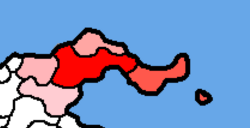Black Purge
| Black Purge | |||
|---|---|---|---|
| Part of The First Kopen Uprising | |||
 Map depicting the Umudin Peninsula, and the regions within it most affected by the Black Purge. | |||
| Date | 1324-1325 | ||
| Location | The Duchy of Jijo, Flatstone | ||
| Caused by | The city of Umudin had been placed under siege by Kopenist revolutionaries during the First Kopen Uprising. The desperation of the heretics resulted in the pillaging of the lands in and around the city of Umudin. | ||
| Goals | Destruction of the Umudin Peninsulas economy. | ||
| Methods | Looting, Siege, Wartime sexual violence | ||
| Status | Relieved by reinforcing Southern Ivili troops in 1325; Kopenist armies dispersed or annihilated. | ||
| Parties to the civil conflict | |||
| Lead figures | |||
| |||
| Number | |||
| |||
| Casualties | |||
| |||
The Black Purge was a religiously motivated atrocity conducted by the members of the Kopenist Separatist movement during the First Kopen Uprising from the year 1320 to 1325, however the events of the Black Purge were mainly concentrated towards the final year of rebellion in 1324 and 1325 due to the detereorating situation of the Kopenist movements militant forces in the region. Jonnas Moska, founder of the Kopenist faith, personally called for the pillaging of the region to ensure that the southern Ivili forces that had been dispatched to oust Kopenist the occupiers gained as little as possible in taking back the region for themselves. The Kopenist army of roughly 2,500 at the time would ultimately be obliterated by the advancing southern Ivili troops, however they had dealt a significant blow the Umudins' regional stability and economy. Thousands of non-Kopenists in the region were rallied and slaughtered by the Kopenist militia's, their bodies being discarded into mass-graves, many of which weren't discovered for centuries after the initial sacking. The modern day province of Jijo sustained the most damage, with an estimated 25% of the regions population having perished during the Black Purge. The diminishment of the Geologist faith in the region due to these events meant that the Kopenists achieved the majority, solidifying their religious claim to it.
Part of a series on the |
|---|
| History of Kopen |
 |
| Kopenist Revolutionaries |
Background
The Kopenist movement had achieved substantial progress during the first few years of the uprising, sweeping across the Umudin peninsula almost completely uncontested due to a significant lack of southern Ivili troops in the region, as many of them had been fighting overseas in Hoterallia and Kakland during their respective invasions. The Kopenists had initially planned to reach the Taverkny clan, a few dozen kilometers past the city of Umudin, which had halted their advance due to the cities strategic importance and outskirt fortifications that had delayed its capture long enough for southern Ivili soldiers to relieve the siege. Jonnas Moska of the Kopenist movement had divided his force of 8,000, which by the time the siege of Umudin had begun had diminished to around 6,000, using one to siege Umudin and the other to garrison the vast swathes of land under Kopenist occupation.
Jonnas Moska
The southern Ivili arrived in 1324 to relieve Umudin with a numerically superior force that was far better equipped and experienced. They made quick work of the Kopenist army, which by the time of their arrival was without leadership, as Jonnas Moska had perished during the siege after being struck by a stray arrow from one of the cities' inner defenders. However, before Jonnas's death, he had ordered for the region to be ransacked by Kopenist forces, having hundreds of farms and buildings looted and subsequently burned, their owners possibly raped before being killed. The ruthlessness of the Kopenist forces is remembered with a sense of distate, their reckless actions having dealt a serious blow to the religions reputation and contributing heavily to the prevention of the religions spread further into Flatstone, ultimately deciding the dominance of the Geologist faith throughout the nation.
During and the Aftermath
It is estimated that up to 6,000 civillians were affected by the Kopenists, living in regions ranging from the westernmost parts of the Jijo to the easternmost coast of the Bebanu. However, the majority of casualties are likely from the province of Jijo, where an estimated 25% of the population almost entirely of which were Geologists, was wiped off the face of the earth by the Kopenist armies and buried in a variety of mass graves scattered around the country. After the arrival of the southern Ivili army and the liberation of the peninsula from the defeated Kopenist occupiers, a few of these mass graves and the ruins of many small farming and fishing villages that dotted the Umudins countryside were discovered, encouraging the southern Ivili to seek out retribution. This in conjunction with the Sacking of Umudin, also conducted by the Kopenists, lead to the actions committed by the southern Ivili army in 1325 and 1326, commonly referred to as the Dead Summer. Consequentially, the region was left devastated for a long period of time after these events, the wars in Kakland and Hoterallia that had taken a toll on the young nations economy not helping the situation. The region wouldn't fully recovered economically for roughly another century.